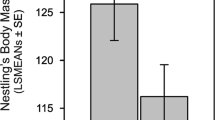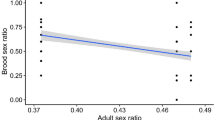Abstract
Tengmalm’s Owls (Aegolius funereus) (TO) exhibit a pronounced sexual size dimorphism in which females are bigger than males, which have to provide food for the breeding female and for the brood. Clutch size and breeding success are strongly influenced by food supply, especially by the abundance of small rodents. Since 1979, the breeding ecology of TO has been studied in a nest box population in the Harz Mountains. In this study, the influences of food supply and other variables on sex allocation of young TO were analysed. Between 2001 and 2011, all 758 nestlings from 176 broods were sampled. Their sex was determined by DNA analysis (PCR amplification of DNA markers on the sex chromosomes). The mean sex ratio was male-biased with 53.4 % male offspring with yearly variations between 43.3 and 66.7 %. Nestling mortality was independent of sex. Food abundance changed between good and bad years. No correlation could be established between food supply by individual fathers and offspring sex ratio. Neither seasonal variation of hatching dates, the hatching order within a clutch nor individual fitness characters of parents had a significant influence on sex ratios. Yearly sex ratios did not diverge significantly from 50 %. The sex ratio fluctuated to the same degree in 5 good years and in 4 bad years. These results are in contrast to a study in Sweden, where an influence was detected within a 3-year vole cycle of food supply on offspring sex ratio. There, the sex ratio was male-biased in the good year, unbiased in the subsequent year and female-biased in the bad year.
Zusammenfassung
Keine Abhängigkeit des Geschlechterverhältnisses der Nestlinge des Rauhfußkauzes (Aegolius funereus) vom Nahrungsangebot oder von anderen biotischen Variablen
Die nachtaktiven Rauhfußkäuze haben einen deutlichen Sexualdimorphismus. Das Weibchen ist größer als das Männchen. Die Nahrungsbeschaffung für die Brut und die Nachkommen erfolgt fast nur durch das Männchen. Die Gelegegröße und der Bruterfolg variieren sehr stark in Abhängigkeit vom Nahrungsangebot, besonders vom Vorkommen der Nagetiere. Die Nestlinge schlüpfen in Zeitabständen von 1 bis 2 Tagen. In einem 200 qkm großen Fichtenwaldgebiet im Harz wird seit 1979 die Brutökologie einer Nistkasten-Population des Rauhfußkauzes umfassend untersucht. In diesem Projekt wird auch der Einfluss des Nahrungsangebotes und anderer biotischer Variablen auf das Geschlechterverhältnis nestjunger Käuze analysiert. Zwischen 2001 und 2011 wurden Proben von 758 Nestlingen aus 176 Bruten gewonnen. Ihr Geschlecht wurde mittels DNA-Analytik bestimmt (PCR von DNA-Markern der Geschlechtschromosomen). 53,4 % der Nestlinge waren Männchen. Die jährlichen Mittelwerte der Männchenanteile schwankten ohne signifikante Unterschiede zwischen 43.3 % und 66.7 % und wichen nicht signifikant von der Gleichverteilung der Geschlechter 50 % ab. Die Mortalitätsraten der Nestlinge zeigten keine signifikanten Unterschiede zwischen den Geschlechtern. Die verschiedenen Nahrungsressourcen in guten und schlechten Nagerjahren hatten keinen signifikanten Einfluss auf das Geschlechterverhältnis der Jungvögel. Für das Geschlechterverhältnis aller Nestlinge konnte keine Abhängigkeit von der Güte der Nahrungsversorgung, dem Schlüpfdatum, der Schlüpfreihenfolge und der Anzahl der Geschwister sowie von Eigenschaften der Eltern festgestellt werden. Männliche und weibliche Rauhfußkäuze, die mehrere Bruten durchführten, zeigten eine hohe inter- und intraindividuelle Variabilität der Zusammensetzung an Söhnen und Töchtern zwischen ihren aufeinander folgenden Bruten. Diese Ergebnisse stehen im Widerspruch zu einer vergleichbaren Untersuchung in Schweden, in der ein Einfluss des Nahrungsangebotes auf das Geschlechterverhältnis der aufwachsenden Raufußkäuze festgestellt wurde. In einem Dreijahres-Zyklus von Wühlmäusen war der Anteil der jungen Männchen in einem Gradationsjahr größer und in einem Mangeljahr kleiner als das der jungen Weibchen.



Similar content being viewed by others
References
Baker AJ, Piersma T, Greenslade AD (1999) Molecular vs. phenotypic sexing in red knots. Condor 101:887–893
Benito MM, Gonzalez-Solis J (2007) Sex ratio, sex specific chick mortality and sexual size dimorphism in birds. J Compil 20:1522–1530
Bennett PM, Owens IPF (2002) Evolutionary ecology of birds. Oxford University Press, Oxford
Brommer JR, Karell P, Pihlaja T, Painter JN, Primmer CR, Pietiäinen H (2003) Ural owl sex allocation and parental investment under poor food conditions. Oecologia 137:140–147
Cassey P, Ewen JG, Möller AP (2006) Revised evidence for facultative sex ratio adjustment in birds: a correction. Proc R Soc Lond B 273:3129–3130
Darwin C (1871) The descent of man and selection in relation to sex. John Murray, London
Donald PF (2007) Adult sex ratio in wild bird populations. Ibis 149:671–692
Eldegard K, Sonerud GA (2009) Female offspring desertion and male-only care increase with natural and experimental increase in food abundance. Proc R Soc Lond B 276:1713–1721
Fisher RA (1930) The genetical theory of natural selection. Clarendon, Oxford
Gonzalez-Solis J, Becker PH, Wendeln H, Wink M (2005) Hatching sex ratio and sex specific chick mortality in common terns (Sterna hirundo). J Ornithol 146:235–243
Hardy ICW (2002) Sex ratios—conceps and research methods. Cambridge University Press, Cambridge
Hill JM, Walsh J, Kovach AI, Elphick CS (2013) Male-skewed sex ratio in saltmarsh sparrow nestlings. Condor 115:411–420
Hipkiss T (2002) Brood sex ratio and sex differences in Tengmalm’s owl (Aegolius funereus). Dissertation, Umea University
Hipkiss T, Hörnfeldt B (2004) High interannual variation in the hatching sex ratio of Tengmalm’s owl broods during a vole cycle. Popul Ecol 46:263–268
Hipkiss T, Hörnfeldt B, Eklund U, Berlin S (2002) Year-dependent sex-biased mortality in supplementary-fed Tengmalm’s owl nestlings. J Anim Ecol 71:693–699
Hörnfeldt B, Carlsson B-G, Löfgren O, Eklund U (1990) Effects of cyclic food supply on breeding performance in Tengmalm’s owl (Aegolius funereus). Can J Zool 68:522–530
Hörnfeldt B, Hipkiss T, Fridolfsen AK, Eklund U, Ellegren H (2001) Sex ratio and fledging success of supplementary-fed Tengmalm’s owl broods. Mol Ecol 9:187–192
Kahn NW, John JS, Quinn TW (1998) Chromosome-specific intron-size differences in the avian CHD gene provide an efficient method for sex identification in birds. Auk 115:1074–1078
Kekkonen J, Kolunen H, Pietiäinen H, Karell P, Brommer JF (2008) Tawny owl reproduction and offspring sex ratios under variable food conditions. J Ornithol 149:59–66
Korpimäki E (1986) Gradients in population fluctuations of Tengmalm’s Owl Aegolius funereus in Europe. Oecologia 69:195–201
Korpimäki E (1988) Diet of Tengmalm’s owls Aegolius funereus: long-term changes and year-to-year variation under cyclic food conditions. Ornis Fenn 65:21–30
Korpimäki E, Hakkarainen H (1991) Fluctuating food supply affects the clutch size of Tengmalm’s owl independent of laying date. Oecologia 85:543–552
Korpimäki E, May CA, Parkin DT, Wetton JH, Wiehn J (2000) Environmental- and parental condition-related variation in sex ratio of kestrel broods. J Avian Biol 31:128–134
Newton I (1989) Lifetime reproduction in birds. Academic, New York
Ristow D, Wink M (2004) Seasonal variation in sex ratio of fledging Eleonora’s Falcon, Falco eleonorae. J Raptor Res 38:320–325
Rösner S, Bogatz K, Trapp H, Grünkorn T, Brandl R (2009) No evidence of skewed secondary sex ratios in nestlings of the Common Raven (Corvus corax). J Ornithol 150:293–297
Sambrook J, Fritsch EF, Maniatis T (1989) Molecular cloning: a laboratory manual. Cold Spring Harbor Laboratory, New York
Schwerdtfeger O (1984) Verhalten und Populationsdynamik des Rauhfußkauzes (Aegolius funereus). Vogelwarte 32:183–200
Schwerdtfeger O (1991) Altersstruktur und Populationsdynamik beim Rauhfußkauz (Aegolius funereus). In: Stubbe M (ed) Populationsökologie Greifvogel- und Eulenarten 2. Uni Halle, Germany, pp 493–506
Schwerdtfeger O (1994) The dispersion dynamics of Tengmalm’s Owl (Aegolius funereus) in Central Europe. In: Meyburg BU, Chancellor RC (ed) Raptor Conservation Today. Pica Press, London, pp 543–550
Schwerdtfeger O (1996) Wie optimiert der Rauhfußkauz (Aegolius funereus) seine Reproduktionsrate? In: Stubbe M, Stubbe A (eds) Populationsökologie Greifvogel- und Eulenarten 3. Uni Halle, Germany, pp 365–376
Schwerdtfeger O (2000) Entwicklung und Lebenserwartung junger Rauhfußkäuze (Aegolius funereus). In: Stubbe M, Stubbe A (eds) Populationsökologie Greifvogel- und Eulenarten 4. Uni Halle, Germany, pp 505–516
Schwerdtfeger O (2006a) Migration and dispersions dynamic’s in the Metapopulation of Tengmalm’s owl (Aegolius funereus) in Central Europe. J Ornithol 147(Suppl 1):85
Schwerdtfeger O (2006b) Monitoring beim Rauhfußkauz (Aegolius funereus). Welchen Einfluss haben Reproduktionsverhalten und Nestlingssterblichkeit auf die Erfassungsgenauigkeit? In: Stubbe M, Stubbe A (eds) Populationsökologie Greifvogel- und Eulenarten 5. Uni Halle, Germany, pp 585–601
Schwerdtfeger O (2007) Ungewöhnliche Feststellungen zur Verhaltensökologie des Rauhfußkauzes (Aegolius funereus). Vogelwarte 45:310
Schwerdtfeger O (2008) Ist der Rauhfußkauz Aegolius funereus ein echter Harzer ? Über die Bedeutung einer lokalen Population. Vogelk Berichte Niedersachsen 40:247–253
Schwerdtfeger O (2013) Monitoring beim Rauhfußkauz (Aegolius funereus). Die Bedeutung von Balzverhalten und Geschlechterverhältnis. Populationsökologie Greifvogel- und Eulenarten 7. Uni Halle (to be published)
Sutherland WJ, Newton I, Green RE (2004) Bird ecology and conservation: A handbook of techniques. Oxford University Press, New York
Trivers RL (1972) Parental investment and sexual selection. In: Campbell B (ed) Sexual selection and the descent of Man. Aldine, Chicago, pp 136–179
Trivers RL, Willard DE (1973) Natural selection of parental ability to vary sex ratio of offspring. Science 179:90–92
Van Dijk RE, Komdeur J, van der Velde M, Szentirmai I, Yang X, French-Constand R, Szekely T (2008) Offspring sex ratio in the sequentially polygamous Penduline Tit Remiz pendulinus. J Ornithol 149:521–527
West SA, Sheldon BC (2002) Constraints in the evolution of sex ratio adjustment. Science 295:1685–1688
Acknowledgments
Thanks are due to the Niedersächsische Landesforsten, the Nationalpark Harz and the Stadtforst Osterode for providing a driving permit and for support to buy and to maintain the nest-boxes. We thank Hedi Sauer-Gürth, Ariane Eberhardt, Nadine Scholz, Angela Frank, Marcel Paulmann, Tabea Sinkovic and Kathrin Obernberger (IPMB, Heidelberg University) for their help in molecular sexing.
Author information
Authors and Affiliations
Corresponding author
Additional information
Communicated by F. Bairlein.
Rights and permissions
About this article
Cite this article
Schwerdtfeger, O., Wink, M. Lack of correlation between sex ratio and food supply or other biotic variables in nestlings of Tengmalm’s Owl Aegolius funereus . J Ornithol 155, 497–505 (2014). https://doi.org/10.1007/s10336-013-1032-6
Received:
Revised:
Accepted:
Published:
Issue Date:
DOI: https://doi.org/10.1007/s10336-013-1032-6




